 Last additions - Sengakuji Temple & Gishisai 泉岳寺・義士祭 Last additions - Sengakuji Temple & Gishisai 泉岳寺・義士祭 |
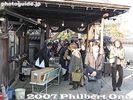
At the gate to enter the graves of the 47 ronin, they sell incense sticks. 四十七士墓所の門Feb 04, 2008
|
|

After reporting to their lord, the group leaves the temple.Feb 03, 2008
|
|
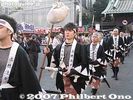
Feb 03, 2008
|
|
|

Leader of the 47 ronin, Oishi Kuranosuke goes in front of the Hondo hall and reported their successful capture of Kira.Feb 03, 2008
|
|
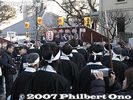
Heading to their lord's grave.Feb 03, 2008
|
|

The Gishisai on Dec. 14 marks the day when the 47 loyal retainers attacked and beheaded Kira to avenge their master (Lord Asano) in 1702. They then marched to Sengakuji to present the head to their master's grave. This is reenacted annually.Feb 03, 2008
|
|
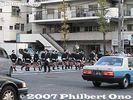
They cross the street full of cars. A Gishisai Festival is also held in Ako in Hyogo Prefecture.Feb 03, 2008
|
|

Statue of Oishi Kuranosuke, leader of the 47 loyal retainers. He's looking (glaring) east toward Edo. The temple grounds also have the Ako Samurai Memorial Hall and the well where they washed Kira's head.Feb 03, 2008
|
|
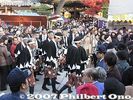
The 47 masterless samurai then proceed to the nearby grave of their Lord Asano.Feb 03, 2008
|
|
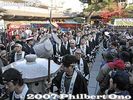
Gishisai on Dec. 14: Headed by Oishi Kuranosuke, the 47 loyal retainers arrive Sengakuji temple.Feb 03, 2008
|
|

The gravestones all look alike. There is a map showing who is buried where.Feb 03, 2008
|
|
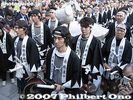
Gishisai: Kira's head strung on a spear is brought to Sengakuji temple.Feb 03, 2008
|
|

Feb 03, 2008
|
|
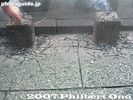
Worshippers pile on the incenseFeb 03, 2008
|
|
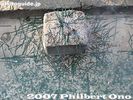
Pile of incense in front of a grave.Feb 03, 2008
|
|

Feb 03, 2008
|
|
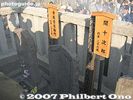
Names are clearly written on wooden plaques.Feb 03, 2008
|
|

Oishi Kuranosuke's graveFeb 03, 2008
|
|

Soon after the 47 retainers committed seppuku on Feb. 4, 1703, they were buried here.Feb 03, 2008
|
|

People buy incense sticks at the gravesite gate and place incense at all the graves.Feb 03, 2008
|
|

Very thick smoke, but not suffocating. People with asthma or lung problems might want to avoid this.Feb 03, 2008
|
|

The smoke can kill all the bugs in your fur or wool coat.Feb 03, 2008
|
|
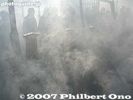
On the Gishisai day or anniversary of the attack on Kira, there is an extra amount of people and incense smoke.Feb 03, 2008
|
|
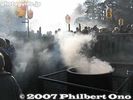
Incense burnerFeb 03, 2008
|
|
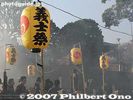
Gishisai lanterns.Feb 03, 2008
|
|

The graves all have headstones with the loyal retainer's name on it and age at death.Feb 03, 2008
|
|

Large way going to the graves of the 47 ronin masterless samurai at Sengakuji temple. 四十七士墓所Feb 03, 2008
|
|
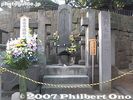
Grave of Lord Asano Naganori (Takumi-no-kami) (1667-1701) of Ako Province.Feb 03, 2008
|
|
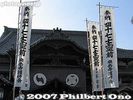
Since it was during the Gishisai Festival on Dec. 14, banners are in front of the Hondo hall for the 47 loyal retainers of Ako. Read about it here.Feb 03, 2008
|
|

Asano clan graveFeb 03, 2008
|
|
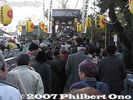
During the Gishisai Festival in mid-Dec., the temple is especially crowded. This is the long line to enter the graves of the 47 loyal samurai retainers. The gravesite's gate up ahead was the back gate of the Ako estate in Tokyo. Later moved here.Feb 03, 2008
|
|
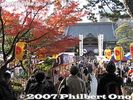
Path to the Hondo temple hall. 本堂Feb 03, 2008
|
|
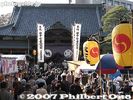
Hondo temple hall. The original hall was destroyed during World War II. Reconstructed in 1953 in the Kamakura style. 本堂Feb 03, 2008
|
|

After the Chumon is the Sanmon Gate which is the temple's main gate. Reconstructed in 1832. 山門Feb 03, 2008
|
|
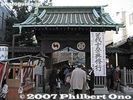
First built by Tokugawa Ieyasu in 1612, Sengakuji temple belongs to the Zen Soto sect. This is the Chumon Gate, facing the south, the first gate most people pass through to enter Sengakuji temple. Reconstructed in 1836. 中門Feb 03, 2008
|
|
|
|